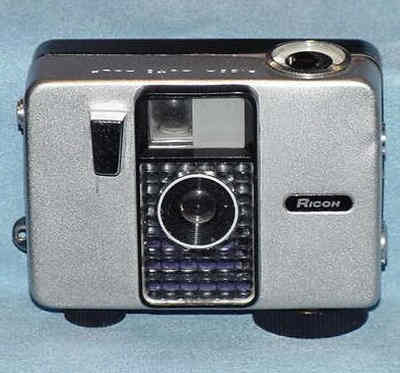
RICOH AUTO HALF FRAME CAMERAS

This popular model was released in 1960. The features that made it popular were its small size, automatic exposure and built-in spring-motor drive. It had a trusty four element, three group 25mm (f2.8) fixed-focus lens that would appear on Ricoh (and other) half-frames for years to come. The shutter had two speeds of 1/30 (for flash) and 1/125. The selenium meter around the lens controlled the exposure by adjusting the aperture from f2.8 to f22 at 1/125. The f-stop could be set for flash use in a tiny window under the ISO dial on top. The spring drive could advance 25 - 30 exposures before winding was needed. It did not offer motorized rewind, like the Canon Dial cameras, but it had a tripod socket and PC contact on the side. It lacked a regular flash shoe, but a cold flash shoe was available as an accessory and screwed into the tripod socket. Ricoh also made several flash units that screwed into the tripod socket and made contact with the PC contact (which is next to the tripod socket) -- a nice setup that they used on several of their cameras, not just half-frames. The shutter release was on the front, I guess to avoid unintentional pressure -- which would go through the entire roll in a few seconds! It lacked a cable release connection, and has ISO settings from 12 to 200. The back was not hinged, it pops off -- which actually makes loading the camera easier. As available accessories, it had unusual, rectangular filters that snapped on over the lens, meter and viewfinder. Due to its age, it is often seen with a dead meter.
Shortly after its introduction, Ricoh came out with an updated version of the Auto Half. The changes are significant, but easy to overlook. It still had the same trusty 25mm (f2.8) lens with four elements in three groups, but now it is a focusing lens -- if you look closely. There is a red dot next to the lens that is the focusing index. There are four distance icons on the lens ring that you line up to the red dot: Mountain (infinity), Person (full figure), Dot (hyperfocal distance), and Head (close-up). This version now has ISO settings from 25 - 400. Plus the viewfinder had a special mark to aid in correct exposure settings. It is a dot right in the middle of the viewfinder which is normally yellowish -- meaning "adaquate light". If it appears reddish, it means inadequate light -- use flash. Crude, but effective. Another change was that the back is now hinged. Another "improvement" was this model came with various designs on the faceplate. The Ricoh name is now moved up higher on the camera face and is in red. It still lacks a cable release connection, but this is by far the better model, although it is harder to find.
COPYRIGHT @ 1995-2020 by Joe McGloin. All Rights Reserved.